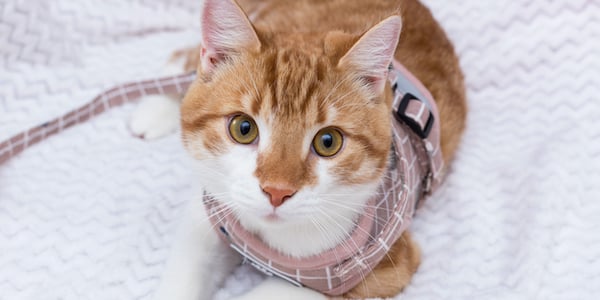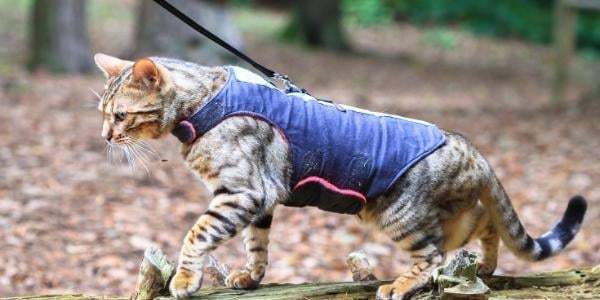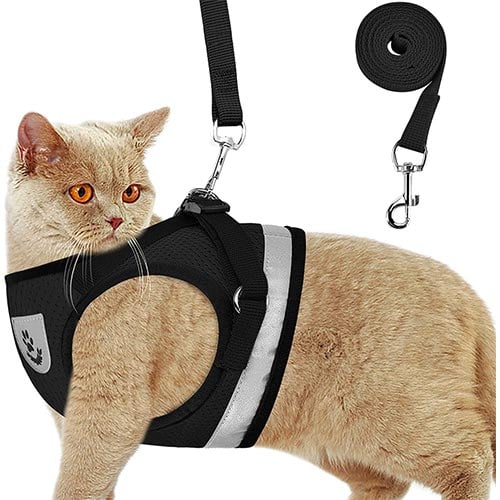 You’ve probably seen videos of adventure cats hiking through the mountains or riding in a kayak with their human.
You’ve probably seen videos of adventure cats hiking through the mountains or riding in a kayak with their human.
Ever wonder if your cat would be up for that kind of adventure? Or even a simple leashed walk around the yard?
Harness and leash walks can be a great way for some cats to explore safely and expand their horizons, whether it’s just beyond the back door or deep in the wilderness.
But where do you start?
With some insights into cat behavior, a little desensitization, and learning how to put a cat harness on.
Getting Your Cat Comfortable Wearing a Harness
A little patience and training will go a long way in the evolution of your adventure cat.
First up, help your cat get used to the harness. This is not the time to dive into the deep end and see how it goes. If you try to force your cat into a harness, it's likely to be a rough experience. And they'll make negative associations with the harness, which you want to avoid.
What You’ll Need:
- Cat Harness
- Cat Treats (or another form of reward)
- Clicker (watch this video to learn how to clicker train your cat) or a Marker Word (such as “yes!")
Learning How a Cat Harness Goes on
It may seem strange to tackle this step before you’ve even introduced your cat to the harness. But the truth is, you need to be comfortable working with the harness first. You don’t want to be fussing and fidgeting with it the first time it’s on your cat.
How does a cat harness go on? That depends on the style. Most are pretty straightforward. You’ll probably be strapping the cat in at the chest, belly, sides, and/or back. There are also styles with head or leg openings your cat may need to slip into.
Take a minute to read the manufacturer’s instructions. Test out the buckles to make sure you can easily get them opened and closed (and that they’re nice and secure). It’s also a good idea to get familiar with the size adjustment options. You may need to do some sizing before you buckle your cat in for the first time.

Techniques to Help Your Cat Feel Comfortable Wearing a Harness
If you’ve seen videos of cats who have a harness put on and then immediately flop over on the floor, you know exactly what NOT to do. We’re going to use a little systematic desensitization and counterconditioning to introduce your cat to the harness in a positive way. They’re going to tell you how fast or slow you need to move. Pay attention to body language throughout this process.
Systematic Desensitization
Exposing your cat to a trigger (in this case, the harness), starting at such a low intensity that they have no stress response. I outline the level of exposure in more detail below in the step-by-step training section.
Then you very slowly increase the intensity bit by bit, never going beyond their comfort level. Think of it as the volume knob on a stereo (if anyone remembers those). You’re starting with the volume so low your cat doesn’t even realize it’s on. Then you’re turning it up, one notch at a time, in such small increments that your cat isn’t having any reaction at all. Before they know it, the volume is up, and they’ve learned this thing that used to scare them isn’t so scary.
Counter Conditioning
Pairing something good (treats) with something a cat reacts to negatively (such as wearing a harness), so the bad thing doesn’t seem so bad after all. Positive associations!

Cat Harness Training Step-by-Step
Now you're going to start working with your cat to get them comfortable with the harness. You're simply looking at your starting point (not wearing the harness) and your goal ending point (wearing the harness with ease) and mapping out incremental steps to get you from A to B with no stress on the cat.
If your cat is clicker trained, you'll click each time they have a neutral (or positive) reaction to the following steps and then reward them with a treat. If they're not clicker trained, you can just say "yes" before rewarding them.
Training tip: Have these sessions when your cat is relaxed.
- Set the harness down near your cat and provide a treat.
- If they’re calm and relaxed, move the harness a bit closer and treat.
- If they’re calm, hold the harness up. If they give it a sniff or check it out, give a treat.
- Next, touch the harness to their body for just a second and reward.
- Hold the harness to their body for a few seconds and reward.
- You get the idea. Slowly progress to draping the harness over their back for a few seconds, reward, and so on.
If your cat is clicker trained, simply add a click as you try the next step, and your cat remains calm.
- If the harness has loud Velcro or clips, you might open and close them a few times so your cat can get comfortable with the sound before you have the harness on them, then reward.
- If the harness has an opening that they'll need to put their head through, hold it up in front of them. Have a treat in your hand. Use the treat to slowly lure their head through the opening. This may take a few sessions. Break it down into smaller steps as needed.
- Slowly progress to putting the harness on, rewarding after every tiny step forward. And always be watching body language. Stop right away and end on a positive note if they look anything other than positive or neutral.
Continue to work with your cat to put the harness on and remove it. Then you can slowly increase the amount of time they wear the harness. Before you know it, they feel completely comfortable in the harness, and they’ve made lots of positive associations with the process of putting it on, wearing it, and taking it off.
It may seem like a lot of work. But these sessions often move very quickly. And now you’ve set your cat up for success.
Check out this video to see the process in action:
For each step, watch body language closely. If they show any signs of stress or discomfort, simply go back a step or two.
Pulling their head back, staring at the harness, fidgeting, or repositioning their body, turning their ears to the side or back even a little, swishing the tail — these are indications that they’re uncomfortable and we never want to push to that point. So, either back up to the place they were last comfortable and start moving forward again or just stop the session right there and try again later.
Always end training sessions with your cat on a positive note, with a treat and lots of praise!
What Treats Should You Use to Harness Train Your Cat?

Ideally, you want a treat your cat can eat quickly so they can return their focus to you and the training. Low-calorie options help keep those calories from adding up. I like puree options like Churu squeeze treats. You can also water down a little of their wet food so it will flow easily through a syringe or just give a lick of wet food off a spoon.
If your cat is on a prescription diet and treats aren't an option, try using a different brand of the same prescription diet formulation. For example, many cats are on prescription urinary health food from Royal Canin or Hill's Science Diet.
If your cat eats the Royal Canin version every day, try the Hill's version for treats. You're getting the same dietary benefit, but the taste is likely to be different, which can be rewarding for your cat. Of course, check with your veterinarian first.
What if Your Cat Doesn't Want Treats for Harness Training?
If your cat isn't food motivated, this may be a bit more challenging, but it can be done. You can use anything they love as a reward. Petting or brushing is a great option. Some cats respond very well to verbal praise. Even short play sessions with a favorite toy will work. It's best to use rewards you can give quickly and easily so you can get back to training without a big distraction. That's why treats are a great option when possible, but work with what you've got!
Choosing the Right Cat Harness and Leash
First off, avoid attaching a leash to a standard collar. There are issues of both physical safety and control if your cat is only secured around the neck instead of the body. So, always use a proper cat harness. And don’t try a DIY cat harness or leash. Stick with reputable products that have positive reviews.
Cat Harnesses
Unfortunately, I’ve never found a harness my cat can’t get out of. No cat harness is escape-proof. This is why considering your cat’s temperament is just as important as selecting the right harness.
Your best bet is to test a few different harness styles in a controlled environment and see which options feel most secure. Of course, you'll need to do a little training first.
When selecting a harness, you must find a balance between stretch and security. It should have enough stretch to allow your cat to move freely. Remember, a cat’s skin is loose because they stretch and move in ways that tight skin, or a tight harness, won’t accommodate. But if it’s too stretchy, your cat will be able to wiggle right out.
Measure your cat’s neck as well as their body circumference just behind the front legs so you can select the correct size. Tip: If you don't have a soft measuring tape to measure your cat with, use a piece of string, then measure its length with your ruler or a traditional retractable tape measure.
There are three types of harnesses to consider, though you’ll see the names used interchangeably.
- A jacket or vest-style harness is designed more like … well … a jacket or vest. These, like the Gauterf vest harness below, are my preferred option. They cover a large portion of the cat’s back and can offer a sense of security, much like a ThunderShirt®. I’ve found the styles that also cover a portion of the chest are best to keep the jacket from sliding left and right over my cat’s shoulders.
- Strap-style harnesses are essentially a series of straps running around the body just behind the front legs, around the neck, and connecting the two along the chest and back.
Finally, there are harnesses that combine elements of both the jacket and strap style, such as this soft mesh harness:
If you’ve found a harness that you love, please let us know in the comments!
Cat Leashes
Whether you use the leash that comes with the harness or purchase one separately, you want a style that securely fastens to the harness. Don't underestimate your cat's strength. If they get scared and take off, they may be able to break a plastic or thin metal clasp.
Look for strong, thick metal clasps. Any sturdy material like leather or nylon works well for the leash. I personally suggest sticking with shorter leashes. Anything more than a few feet gives your cat the freedom to jump into trees, over fences, crawl under shrubs, or cars. They can get into tricky situations quickly, so it's best to keep them close and make sure you have control of the leash.
We have sturdy leash recommendations from our dog trainer, and frankly, a leash for a dog works for a cat. It comes down to your personal preference.
Avoid retractable leashes. They can be difficult to manage. And if you're in a tense situation where you need to quickly get your cat out of an area or keep them from sprinting off after prey or another cat, you don't want to be fumbling with it. Remember, cats can run up to 30 mph and jump more than 5 feet without a running start. They move fast, and retractable leashes don't give you the control you need. It's simply unsafe.
Will Your Cat Enjoy Going for a Walk?
Some cats are made for outdoor excursions. Others not so much. And there are those who just need a little work to get there. It’s vital to understand some things about cats and their nature before you head outside.
Does your cat have a confident or nervous disposition? Those felines who walk right up to strangers, aren’t bothered when you rearrange the furniture, and stay super calm in the car or at the vet are in a better position to enjoy outdoor time, especially if you want to visit new places with them.
On the other hand, if your cat is a little anxious around new things, gets startled when someone knocks on the door, or hides anytime you have company over, the unfamiliarity and lack of control that comes with walks might not be ideal for them. That’s not to say you can’t work on these issues and increase their confidence. You absolutely can. A certified feline training and behavior consultant can give you the tools to do this.
But it’s important to consider your cat’s safety above all else. Walking outdoors can be wonderful for cats with the right temperament and in carefully controlled situations. However, it’s not a necessity. There are other ways to give your cat enrichment and even time outside, without risking an escape or negative experience.
And even if outdoor walks aren't right for your cat, teaching them to be comfortable wearing a harness is still helpful.
Jacket-style harnesses can have a calming effect in stressful situations such as thunderstorms or during fireworks, much like a ThunderShirt ®. You may find a harness useful if you're dealing with play aggression. They can provide extra security during travel and veterinary visits. And if your cat is ever being introduced to another pet, a harness gives you a little control to keep them from rushing toward the other animal (be it in a friendly or aggressive way).
®. You may find a harness useful if you're dealing with play aggression. They can provide extra security during travel and veterinary visits. And if your cat is ever being introduced to another pet, a harness gives you a little control to keep them from rushing toward the other animal (be it in a friendly or aggressive way).
So, give it a shot. Get yourself a good harness and leash, do a little training, and see if your cat might be up for an adventure. If not, that’s perfectly fine. Just enjoy the time you had bonding throughout the process.





